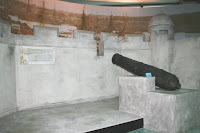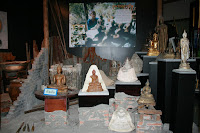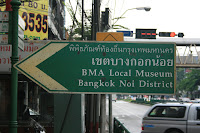 The Bangkok city administration launched a program to have local museums in every of the 50 district of the city some years ago. The one for the district Bangkok Noi is located not that far away from our home in Bangkok, and coincidentally it is the only one the 20 district museums opened so far which was ever featured in English at Tour Bangkok Legacies, so I could easily get the location and opening times - important to note it is closed on Mondays and Tuesdays.
The Bangkok city administration launched a program to have local museums in every of the 50 district of the city some years ago. The one for the district Bangkok Noi is located not that far away from our home in Bangkok, and coincidentally it is the only one the 20 district museums opened so far which was ever featured in English at Tour Bangkok Legacies, so I could easily get the location and opening times - important to note it is closed on Mondays and Tuesdays.In fact I visited that museum twice already, the first time was maybe two or three years ago with my brother-in-law shortly after I had seen that recommendation, and I revisited it in April this year to see if I can get more of it this time, and most of all to take photos. Originally I planned to visit other district museums as well, but as usual in vacation time ran out so fast, and I only made it to this one on my last day in Bangkok when I could finally do a little walking tour around Bangkok Noi.
 The museum is located in a room of the Suwannaram Witthayakhom school, not far from the district office of Bangkok Noi. It is quite easy to find, there are signs pointing towards it at the Bang Khun Non intersection on Charan Sanitwong Road, near the bridge over Khlong Bangkok Noi. Not far after the intersection the school is to the left, impossible to miss due to a large blue billboard announcing the museum. When you enter the school yard, the museum entrance is at the building to the left.
The museum is located in a room of the Suwannaram Witthayakhom school, not far from the district office of Bangkok Noi. It is quite easy to find, there are signs pointing towards it at the Bang Khun Non intersection on Charan Sanitwong Road, near the bridge over Khlong Bangkok Noi. Not far after the intersection the school is to the left, impossible to miss due to a large blue billboard announcing the museum. When you enter the school yard, the museum entrance is at the building to the left. There is always at least one clerk sitting at the entrance, but sadly they only speak Thai so foreigners have to do a self-guided tour - for Thai visitors they are very happy to explain everything in detail. But as almost all texts at the exhibits are bilingual Thai-English it's easy to get at least a good glimpse on the history and traditions of the district.
There is always at least one clerk sitting at the entrance, but sadly they only speak Thai so foreigners have to do a self-guided tour - for Thai visitors they are very happy to explain everything in detail. But as almost all texts at the exhibits are bilingual Thai-English it's easy to get at least a good glimpse on the history and traditions of the district. Additionally to the text signs with the histories of the district or the important places, there are exhibits for the traditional industries of the area. I have added the photos for two of them - the production of Matum (มะตูม), the bael fruit boiled in syrup to make it a special snack. Another business still present in the district is the casting of Buddha images. Further exhibits are on the production of stone-polished bowls, and the production of another kind of sweet snack, created from roasted rice.
Additionally to the text signs with the histories of the district or the important places, there are exhibits for the traditional industries of the area. I have added the photos for two of them - the production of Matum (มะตูม), the bael fruit boiled in syrup to make it a special snack. Another business still present in the district is the casting of Buddha images. Further exhibits are on the production of stone-polished bowls, and the production of another kind of sweet snack, created from roasted rice. Though the museum is not large, it is worth a visit if you are in the area. And it really deserves more visitors, when I went there I was the first person of the day to sign the guestbook, and the first one for nearly two weeks (the Songkran holiday week was one of it, that can explain the low number a bit). I guess I could say the same about the other district museums, though I haven't yet visited any other one. The city really should make that program more public, the only thing way one learns about it are the signs in the street, the website of the program is hard to find and in Thai only.
Though the museum is not large, it is worth a visit if you are in the area. And it really deserves more visitors, when I went there I was the first person of the day to sign the guestbook, and the first one for nearly two weeks (the Songkran holiday week was one of it, that can explain the low number a bit). I guess I could say the same about the other district museums, though I haven't yet visited any other one. The city really should make that program more public, the only thing way one learns about it are the signs in the street, the website of the program is hard to find and in Thai only.


1 comment:
Thanks for writing about this museum. I visited there this morning and found the photographs from the early days especially fascinating. Reading the descriptions of the district's history has piqued my curiosity. I would be interested in understanding more about the peoples who lived here and the system of governance over time.
Although the posted hours said the museum would open at 9:00 a.m., it was still closed when I arrived at 9:30. A guard told me to return at 10:00 and it might be open then. I started to leave and had almost left the school grounds when someone ran after me to tell me that the museum was now open. I think the museum director had just arrived after finishing her Sunday morning shopping.
I wasn't asked to sign the guest register, which may account for the low number of visitors that you saw.
Post a Comment